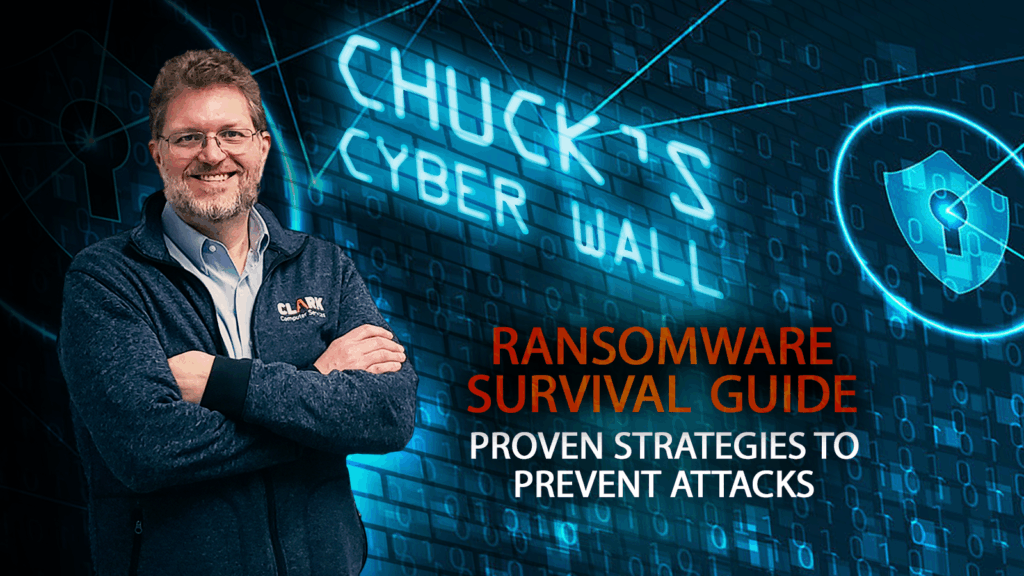Ransomware Survival Guide:
Proven Strategies to Stop Attacks
Chuck's cyber wall
Ransomware is a dangerous and disruptive cybersecurity threat and is among the scariest cyber events that businesses face. Since the first ransomware virus appeared in 1989, this form of cyberattack has evolved into a global criminal enterprise, costing billions of dollars in damages each year. If you’re running a small business that stores or transmits customer information, takes online payments, or handles patient data, ransomware is something you can’t afford to ignore.
What Is Ransomware and Why Is It So Dangerous?
Ransomware is malicious software designed to block access to files, systems, or entire networks by encrypting data until a ransom is paid. In modern attacks, cybercriminals don’t just encrypt your data; they steal it and threaten to leak it online. This strategy, called double extortion, means that even if you have solid backups, your organization may still be at risk for data breaches, lawsuits, and reputation damage.
Contrary to popular belief, these attacks don’t just target large organizations. Small and mid-sized businesses are especially vulnerable because they often lack the advanced defenses that larger companies have in place, but you typically don’t hear about these attacks on the news. When it comes down to it, ransomware is not just a technical problem; it’s a business risk.
How Do Ransomware Attacks Work?
Ransomware attacks usually start with a phishing email or a compromised website. Often, it only takes a single click to launch code that installs ransomware across your network. Once inside, the ransomware uses asymmetric encryption to lock your data. It’s an encryption key that only the attacker has, and your data can’t be unlocked without it.
What makes ransomware so urgent is the pressure tactic: a ticking clock. If payment isn’t made within a specific period, typically 48 to 72 hours, the attackers may destroy the decryption key or publish your stolen data on the dark web. Cybercriminals are also increasingly targeting cloud environments, remote workers, and third-party vendors. This expansion means your cybersecurity supply chain is also part of your risk footprint.
Why Can’t We Stop Ransomware?
Despite advancements in cybersecurity tools and frameworks, ransomware continues to succeed for two reasons: user error and financial motivation. As mentioned above, the majority of attacks start with a phishing email; it takes only one unsuspecting employee clicking a bad link to invite the attackers into your network. Because many companies quietly pay the ransom to avoid downtime or data exposure, attackers have no incentive to stop. In addition, Ransomware-as-a-Service kits are sold on the dark web, making it easier than ever for cybercriminals with little technical skill to launch sophisticated attacks.
Cybersecurity experts and organizations like CISA and NIST are urging businesses to adopt risk-based security frameworks like NIST CSF 2.0, which emphasizes governance, incident response planning, and continuous improvement. However, tools alone aren’t enough: businesses need training, awareness, and policies that make employees the first line of defense.
How Can My Business Prevent Ransomware?
Here’s the good news: defending against ransomware doesn’t have to be complicated. Following these best practices can significantly reduce your risk:
- Maintain secure, offline Backups that are encrypted and stored separately from your primary systems.
- Apply security updates and patches regularly for your operating systems, software, and network devices.
- Require strong passwords and implement Multi-Factor Authentication (MFA) for every account.
- Use endpoint detection and response (EDR) tools and antivirus software that can detect suspicious behavior.
- Avoid public WiFi without a VPN, especially when accessing sensitive systems.
- Train employees regularly on phishing, social engineering, and safe computing habits.
In addition, we offer a Security Risk Assessment that examines your security and provides specific, actionable checkpoints for workstations, networks, mobile devices, and cloud services. If you’re not sure where your gaps are, that’s a great place to start.
Should I Pay the Ransom?
This is a difficult situation to answer. Paying the ransom might feel like the only way to recover your data or prevent a breach. But here are some realities to consider:
- There’s no guarantee the attackers will actually restore your data, even if you pay.
- Paying once can make you a repeat target, either by the same group or others on the dark web.
- You’re funding criminal activity and helping prove that their business model works.
That’s why agencies like CISA and the FBI strongly advise against paying. If you’re hit with a ransomware attack, report it immediately at https://www.us-cert.gov/report and cooperate with law enforcement. The more these attacks are reported, the more intelligence agencies can gather to prevent future incidents.
Keeping Your Business Safe
Unlike other forms of cyber attacks, ransomware is more than a nuisance; it’s an organizational issue. To avoid this type of breach, business leaders need to think in terms of risk management, not just IT services. By taking proactive steps now, including updating your policies, ongoing awareness training, and following the guidance of security frameworks, its possible to reduce the impact of a ransomware attack or avoid it altogether. If you’re unsure where to begin or want help aligning with NIST CSF 2.0 or regulatory frameworks like HIPAA or PCI/DSS, give us a call at 301-456-6931 or send an email to [email protected]. Ransomware prevention isn’t just possible, it’s essential.

Have a Question?
Give us a call
301-456-6931
Get a Free Quote
Previous Blogs

Director of Cybersecurity and Marketing
I’ve always had a love of working with technology, being fortunate enough to have grown up with a grandfather who taught me how to fix things for myself and not be afraid to jump in and get my hands dirty. Over the last three decades, I’ve worked as a technician, trainer, technical writer, and manager in small businesses, enterprise organizations, and government. In addition, I’m an author, having published multiple works available online and in print. You can find my creative work at https://WritingDistracted.com

